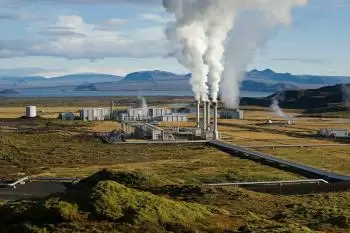
Geothermal power plants are the plants in charge of converting geothermal energy into electricity. These plants get heat from geothermal resources in the inner Earth’s layers to generate steam that powers a generator that produces electricity.
Geothermal energy is the thermal energy in a geothermal resource such as hot springs like the geysers in Northern California. These facilities carry out a thermodynamic exchange at a certain depth of the earth's layers to heat a fluid and generate electricity.
The temperature inside the Earth increases approximately between 25 and 30 degrees Celsius per kilometer of depth. This temperature variation is called a geothermal gradient.
Since heat energy inside the Earth is inexhaustible, it can be said that geothermal electricity generation is a renewable energy source. In addition, it is a clean energy that does not favor global warming.
On a small scale, this geothermal energy is also used in homes for heating and cooling rooms, but not to generate electricity.
How does a geothermal plant work?
The operation of geothermal power plants is similar to other steam turbine power plants.
In all thermoelectric plants, heat is generated in one form or another to heat water using a heat exchanger and creates steam. Then, a steam turbine to an electric generator produces electricity with the steam generated. Subsequently, the fluid is cooled and returned to the heat source.
The difference between different thermoelectric plants is based on how the initial heat is obtained. For example, geothermal power plants use hydrothermal resources. Meanwile, conventional thermal power plants get by burning fossil fuels or through nuclear reactions - nuclear power plants.
In the case of geothermal power plants, heat is obtained from geothermal reservoirs in the inner layers of the Earth.
Types of geothermal power plants
There are three types of geothermal power plants:
1. Binary cycle plants
Binary cycle plants can operate with temperatures that are not very high, at only 57 degrees Celsius. It is the most common type in new projects under construction.
Moderately hot water is passed along with another fluid with a boiling point much lower than water. Since the secondary fluid has such a low boiling point, it quickly vaporizes and can be used to power steam turbines.
They use the Rankine cycle and the Kalina cycle. In addition, the thermal efficiency of binary cycle geothermal plants is about 10-13%.
2. Dry steam geothermal plants
Dry steam geothermal power plants are the most straightforward and oldest designed geothermal plants. They directly use geothermal steam at 150 degrees Celsius or higher to drive steam turbines.
Dry steam geothermal power plants directly take advantage of steam from fractures in the ground to drive a turbine that generates electricity.
3. Flash or flash steam geothermal power plants
Flash or flash steam geothermal plants use water from deep within the Earth. This water is at a temperature of around 200 degrees Celsius or 473 degrees Kelvin due to the thermal energy transmitted by the magma.
Flash steam plants raise high-pressure hot water through wells and into low-pressure reservoirs. Due to this pressure change, the thermodynamic process occurs by which liquid water turns into steam.
Because the center of the Earth is under high pressure, water at this temperature is kept in a liquid state thanks to pressure and thermodynamic laws. So when liquid water is pumped out, where the pressure is atmospheric, it turns into steam.
The steam generated at the outlet drives the steam turbine connected to an electric generator. In this way, electrical energy is generated.
The remaining water that has not vaporized is returned to the reserve. The excess liquid water and condensed steam can be injected into the geothermal reservoirs again. This action contributes to making the process more sustainable process.
What is the efficiency of geothermal power plants?
The energy efficiency of geothermal plants is low, approximately 10 to 23% because geothermal fluids are at low temperatures compared to steam boilers. By the laws of thermodynamics, this low temperature limits the efficiency of heat engines.
In the extraction of valuable energy during electricity production, waste heat is lost unless it can be used directly and locally, for example, in greenhouses, sawmills, or district heating.
The poor energy efficiency of the system does not affect operational costs as much as for a coal or other fossil fuel plant, but it does weigh on the viability of the plant.
To produce more energy than heat pumps consume, generating electricity requires high-temperature geothermal fields and specialized thermal cycles.
As geothermal energy does not rely on intermittent energy sources, like other renewable energy sources such as wind or solar power, its load factor can be very high.